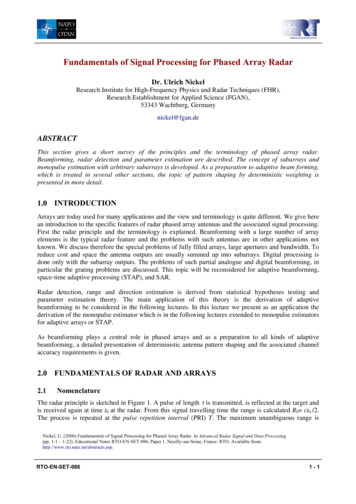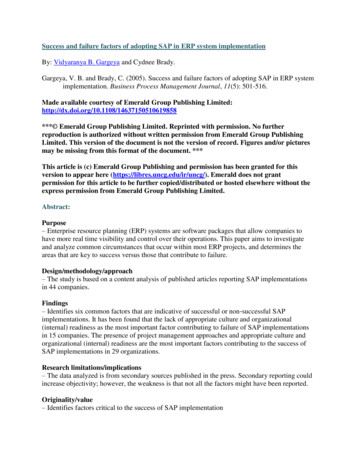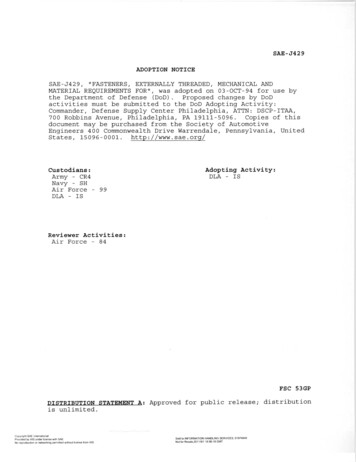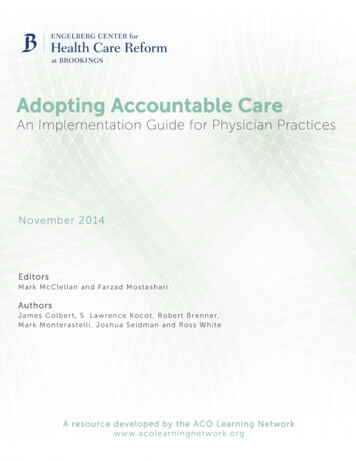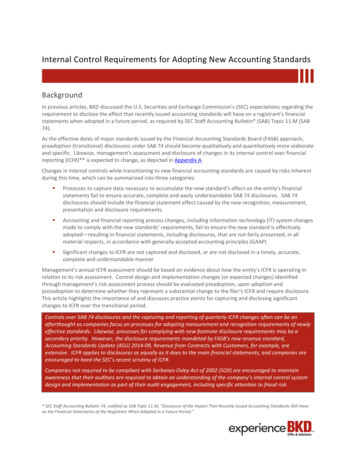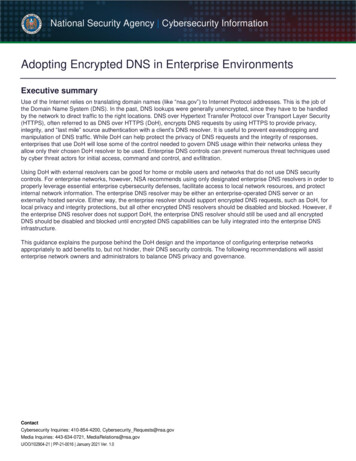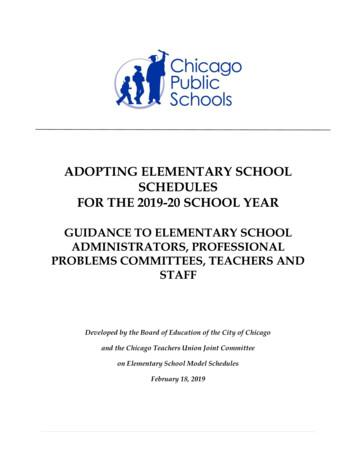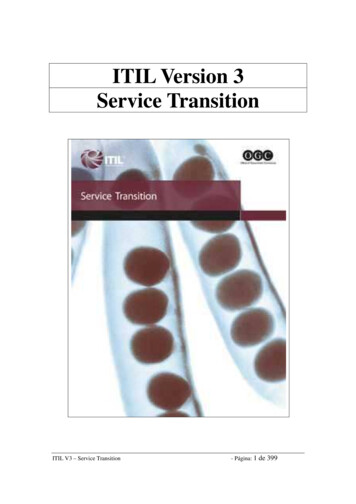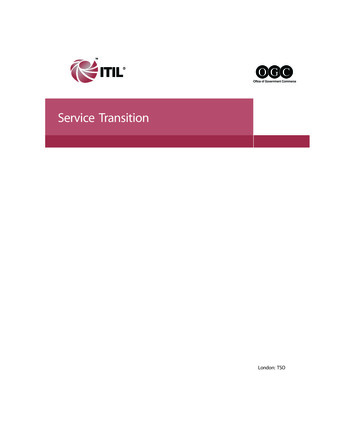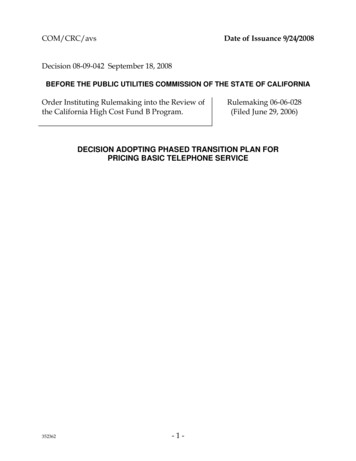
Transcription
COM/CRC/avsDate of Issuance 9/24/2008Decision 08-09-042 September 18, 2008BEFORE THE PUBLIC UTILITIES COMMISSION OF THE STATE OF CALIFORNIAOrder Instituting Rulemaking into the Review ofthe California High Cost Fund B Program.Rulemaking 06-06-028(Filed June 29, 2006)DECISION ADOPTING PHASED TRANSITION PLAN FORPRICING BASIC TELEPHONE SERVICE352362-1-
R.06-06-028 COM/CRC/avsTABLE OF CONTENTSTitlePageDECISION ADOPTING PHASED TRANSITION PLAN FOR PRICING BASICTELEPHONE SERVICE . 21. Introduction. 22. Procedural and Historical Background. 73. Parties’ Position. 123.1. AT&T . 133.2. Verizon . 153.3. SureWest . 173.4. Frontier . 173.5. TURN. 173.6. DRA . 183.7. Sprint . 214. Discussion . 224.1. General Framework for Transition Plan . 224.2. Authorized Duration of the Phase-In Period for Rate Increases . 284.3. Authorized Increases in the Basic Rate During Transition Period . 344.4. Maintaining Basic Rate Affordability After January 1, 2011. 424.5. Annual Certification Process for High-Cost Areas. 465. Comments on Proposed Decision . 486. Assignment of Proceeding . 48Findings of Fact. 49Conclusions of Law . 53ORDER . 54APPENDIX 1 – Derivation of Adjustments to AT&T’s Basic Ratefor Cumulative Consumer Price Index (CPI) ChangesAPPENDIX 2 – Adopted Increases in Basic Rates Effective January 1, 2009-i-
R.06-06-028 COM/CRC/avsDECISION ADOPTING PHASED TRANSITION PLAN FORPRICING BASIC TELEPHONE SERVICE1. IntroductionBy this decision, we adopt a transitional plan for additional flexibilitypermitting adjustments in retail rates for “basic telephone service”1 effectivebeginning January 1, 2009. Pursuant to the Uniform Regulatory Framework(URF) adopted in Decision (D.) 06-08-030, current restrictions on the rates forresidential basic service of the four major incumbent local exchange carriers(ILECs) in California2 are due to expire effective January 1, 2009.ILEC basic rates have remained fixed since the mid-1990s (except for oneminor inflation adjustment in 2008 allowed by the Commission and the stateLegislature through the Digital Infrastructure and Video Competitive Act(DIVCA). Prior to 2008, Verizon last increased its rate in 1995 (from a monthlyrate of 9.75 to 17.25), Frontier last increased its rate in 1996 (from 16.40 to 17.85), SureWest last increased its rate in 1997 (from 16.85 to 18.90), and“Basic Telephone Service” consists of the service elements offered to residentialcustomers as prescribed in the tariff of each respective ILEC, and represents theminimum level of telecommunication services that must remain available ubiquitously,consistent with the universal service principles in D.96-10-066. In response to a requestby parties, the Commission is concurrently evaluating how the “basic service”definition should be updated to recognize the wide array of technological choicesavailable today.1The URF ILECs are: Pacific Bell Telephone Company dba AT&T California (AT&T),Verizon California Inc. (Verizon), SureWest Telephone (SureWest), and CitizensTelecommunications Company of California Inc, dba Frontier CommunicationsCompany of California (Frontier). Any subsequent reference to ILECs, as used in thisdecision is intended to apply exclusively to the URF ILECs. Unless expressly indicatedotherwise, references to ILECs are not intended to refer to any small independent localexchange carriers. Any subsequent references herein to “high-cost” areas pertainexclusively to the B-Fund program.2-2-
R.06-06-028 COM/CRC/avsAT&T last increased its rate in 1995 (from 8.35 to 11.25, subsequently loweredto 10.69 in 1999). Monthly rates for AT&T customers in California are thelowest in the nation and more than 8 per month lower than the nationwideaverage.3Today we also adopt as an interim California LifeLine Telephone Program(LifeLine) rate increase a basic service rate cap for the period beginningJanuary 1, 2009 through December 31, 2010 of 25% of the rate cap increment thatwe authorize today. In doing so, and as necessary to comply with today’sdecision, we temporarily suspend General Order 153, Sec. 8.1.4, which otherwiselimits LifeLine rate discounts to 50%.4 This authorization will expire uponissuance of a decision in our Universal Service proceeding (R.06-05-028),addressing how the LifeLine program will be changed to reflect the Basic RateDecision adopted today.5We direct parties in the Universal Service Docket (R.06-05-028) to filecomments on October 1, 2008, to refresh the record, including considerations ofaffordability, avoiding rate shock, and the impact of the LifeLine subsidy onnonLifeLine customers; funding for needed increase in LifeLine subsidies; andSee FCC’s 2007 Reference Book of Rates, Price Indices, and Household Expendituresfor Telephone Service, Table 1.3 (rates from the Urban Rates Survey as ofOctober 15, 2006).3Under Pub. Util. Code § 874, we are directed to establish LifeLine rates at “no[ ]more than 50 percent of [the basic service rate],” and we rely upon that statutoryauthority in our action today.4The LifeLine Program, formerly known as the Universal Service LifeLine TelephoneService (ULTS) Program, was established by the Commission in compliance with Pub.Util. Code § 871 and provides discounted basic residential (landline) telephone servicesto eligible low income households.5-3-
R.06-06-028 COM/CRC/avsany reforms to the LifeLine program structure such as changes in eligibilityand/or services that are recommended in light of today’s decision. We committo adopt our decision on LifeLine reform in R.06-05-028, including the finalLifeLine basic rates, with an effective date of January 1, 2009.D.06-08-030 determined that the voice market in California is competitiveand D.07-09-020 reaffirmed that finding and determined that after a transitionperiod, prices should be based on competitive market forces.6 The plan adoptedherein will allow for ILEC basic rates to transition to market-based pricingbeginning January 1, 2009, through an orderly phased process that avoids rateshock while preserving affordability. The basic provisions are as follows:1. AT&T, Verizon, SureWest, and Frontier (the ILECs) shalleach be permitted, but not required, to increase their basicrates by prescribed amounts over a two-year phase-inperiod beginning January 1, 2009, as follows.2. Each of the ILECs is permitted to increase its basic flat rateby up to 3.25 effective January 1, 2009 and by up to anadditional 3.25 effective January 1, 2010. These increasescapture the cumulative difference (between nominal andinflation-adjusted dollar value in the AT&T basic rate sinceAT&T’s basic rate was frozen in 1995 throughDecember 31, 2010), applied in equal installments over atwo-year period.3. In order to be consistent with the flat rate adjustments, eachof the ILECs is also permitted, but not required, to increasebasic rates for measured residential service by the samepercentage as applies to the corresponding flat rateincrease. The resulting percentage increases allowed forSee D.06-08-030 at 132, FOFs 77, 86, COLs 20, 28, D.07-09-020 OPs 7-8, 13, as modifiedby D.07-11-039. As noted above, the Commission has a LifeLine program that willaddress issues relating to affordability of telephone service by low-income residents.6-4-
R.06-06-028 COM/CRC/avsmeasured service rates are: (a) For AT&T – 30% for 2009and 23% for 2010; (b) For Verizon- 18% for 2009 and 16%for 2010; for SureWest – 17% for 2009 and 15% for 2010; forFrontier – 18% for 2009 and 15% for 2010.4. The authorization to increase the basic service rate capmeans that the ILEC may elect to charge less than or equalto the capped amount, but may not charge more. TheCommission is not requiring the ILEC to raise its basic ratebut giving it permission to do so if it so desires to meetcurrent market conditions. If an ILEC does increase basicrates pursuant to the additional flexibility granted in thisdecision, the ILEC must first file an advice letter andprovide 30-day advance notice of the increase to affectedcustomers pursuant to D.06-08-030 (Ordering Paragraph 9).5. Effective beginning January 1, 2011, all four ILECs willacquire full pricing flexibility for stand-alone basic rates inregions where basic service is not subsidized by theCalifornia High-Cost Fund B (CHCF-B) (and excludingLifeline).76. In areas where basic service continues to be supported bythe B-Fund, any rate adjustments implemented by aCarrier of Last Resort (COLR) for stand-alone basic serviceafter January 1, 2011, may not exceed (a) 150% of thehighest rate for stand-alone basic service offered by thatsame COLR outside of the high-cost areas, or (b) thehigh-cost benchmark of 36 minus the EUCL, whichever islower.8 This restriction will only apply to those carriersPossible reform to the Lifeline program, including preserving affordability resultingfrom any effects from changes authorized in this decision, is before us in Rulemaking(R.) 06-05-028. We make no prejudgment in this proceeding as to how Lifeline will bereformed.7Rules for reverse auctions are currently being formulated as the means by which aCOLR will be selected, regions where B-Fund support will be applied, and amount ofB-Fund support will be determined. In the event that a carrier other than the ILECshould take over as COLR in a given high-cost area, then any rate restrictions on basic8Footnote continued on next page-5-
R.06-06-028 COM/CRC/avsserving in high-cost regions where they are designated as aCOLR. The restriction will not apply to any carriers inregions where they are not designated to receive B-Fundsupport as a COLR.7. LifeLine rates for basic flat rate and measured service willbe affected as previously explained above.With the expiration of the remaining rate freeze on January 1, 2009, we areseeking to provide for an orderly transition of the basic rate to market-basedpricing while preserving affordability in high-cost areas. Under the planadopted herein, customers will experience more market-driven pricing of basicservice. Given the level of competition in the marketplace, we believe the ILECsshould be allowed to adjust the basic rate to meet their unregulated competitionin a flexible manner. This transition plan is builds upon reforms initiated inPhase I of this proceeding, in which we reduced CHCF-B support by more than 300 million per year through the phase-in of a new 36 benchmark to calculatesupport amounts. At the same time, we retain appropriate safeguards topreserve the affordability of stand-alone basic service, particularly in “high-cost”areas. If basic service becomes unaffordable to customers, we will fall short ofour long-standing goal of universal telephone service.9service rates prescribed by this Decision would apply thereafter to that new COLR. Weinstitute this requirement as an interim measure for the period after January 1, 2011, toprovide an additional level of protection, though we do not anticipate it will ever beinvoked as additional changes to the CHCF-B methodology will supersede thisrequirement.Policies enacted by the Legislature and the Commission have enabled California toconsistently have one of the highest telephone penetration rates in the nation for thepast 20 years. (See CPUC Universal Service Telephone Report to the CaliforniaLegislature at 4-5, 16, May 2008.) Thus, even though the real inflation-adjusted price ofbasic telephone service has fallen between 1995 and 2007, price has had little effect on9Footnote continued on next page-6-
R.06-06-028 COM/CRC/avsThe transition process that we authorize herein continues the reformmeasures begun in URF and continued in Phase I of this Universal Service BFund proceeding, which resulted in a major retargeting of B-Fund subsidies to“carriers of last resort” (COLRs). As determined in D.07-09-020, beginning onJuly 1, 2009, high-cost support will be limited to regions with a proxy cost above 36 per line. We also intend to further update the level of high-cost support byimplementing a reverse auction process to ensure that affordable basic serviceremains available while minimizing the required subsidy. Protections forcustomers within designated high-cost areas similar to those that we adopt inthis decision will be incorporated into the design of the reverse auction.2. Procedural and Historical BackgroundThis decision implements provisions of Phase II of this proceedingconcerning how basic rates may be adjusted subsequent to January 1, 2009. As aframework for implementation, it is useful to review how the Commission’spricing policies have evolved to ensure affordable basic service within thechanging dynamics of technology and competition within the industry.In the late 1980s, we replaced the long-standing practice of reliance oncost-of-service studies for ILEC rate setting, and instead implemented a moremodern price cap index mechanism, in recognition of the increasingly importantrole of competition in the telecommunications industry. This “New Regulatorypenetration rates for basic service. See also Study on Affordability of Basic TelephoneService, 2004, Field Research Corporation, Volume 1 at 2.3a and 5.2a and Volume 2at 4.7 (both mean and median total cost per month of respondents were significantlyhigher than actual monthly cost, and higher than new high cost benchmark).-7-
R.06-06-028 COM/CRC/avsFramework” (NRF), was adopted for the two largest ILECs,10 and wassubsequently authorized for the two mid-sized ILECs.11Under NRF, ILEC services were accorded differing categories of pricingflexibility based on the competitiveness of the underlying services. “Basicmonopoly services,” including basic exchange service, were the accorded themost restrictive pricing. “Partially competitive” services were less restrictive,with rates capped subject to downward flexibility. Pricing of “competitive”services was accorded the maximum flexibility allowed by law.In 1995, we effectively froze ILEC basic service rates12 at a level set torecover one-half of the ILEC’s costs, and all other rate elements to recover theremaining costs of service. In this manner, we provided assurance that basicservice remained affordable, at least for that year, 1995. Basic service ratesremained frozen as we implemented the B-Fund program in 1996, pursuant toPub. Util. Code § 739.3, as part of our framework to promote universal service aslocal exchange markets opened to competition.Prior to the B-Fund, basic telephone service costs had beencross-subsidized implicitly through higher rates for other services.13 InRe Alternative Regulatory Frameworks for Local Exchange Carriers, D.89-10-031,33 CPUC2d 43, 61 (1989).10See Re Citizens Utilities Company of California, D.95-11-024, 62 CPUC2d 244 (1995),and Re Roseville Telephone Company, D.96-12-074, 70 CPUC2d 88 (1996), respectively.11Re Incentive-Based Regulatory Framework for Local Exchange Carriers, D.95-12-052,63 CPUC2d 377, 381 (1995).12Because the ILEC basic rates were based upon an average between high and low costareas, basic residential rates in high cost areas were internally subsidized by revenues inmore profitable exchanges, subsidies between product lines, and from other sources ofrevenues. (See D.95-07-050; 60 CPUC2d, 536, 546.)13-8-
R.06-06-028 COM/CRC/avsD.96-10-066, the B-Fund created an explicit subsidy, and eliminated the implicitcross subsidies by reducing rates for many non-basic services that had beenpriced above cost.14 By replacing implicit pricing cross-subsidies with an explicitsubsidy, the CHCF-B facilitated competitive market-based pricing for otherservices, while supporting the affordability of basic service. Over the followingdecade, we continued to impose price caps under the provisions of theNRF program.Basic rates have remained frozen since then with the limited exception ofinflation-adjusted increases of 2.36% authorized in D.07-09-020 for AT&T andVerizon rate caps, effective January 1, 2008. These increases were permittedunder Pub. Util. Code § 5040 which codifies provisions of the 2006 DigitalInfrastructure and Video Competition Act (DIVCA).15 AT&T and Verizon maycharge less than the capped rate, but not more.The table below summarizes the tariff flat rate for basic residential servicethat was in effect for each ILEC as of December 31, 2007, as well as theadjustments for 2008 that were authorized for AT&T and Verizon:Basic Flat Rate CapEffective 12/31/07Effective 1/1/08For example, D.98-07-033 adopted 305.2 million in rate reductions in toll, switchedaccess, ZUM/local usage, and custom calling features for Pacific Bell to offset explicitsubsidy support from the B-Fund. Companies that did not reduce non-basic ratesapplied a surcredit on customer bills to offset B-Fund receipts.14DIVCA permits inflation-related adjustments to basic rates prior to January 1, 2009,limited to carriers that obtain a statewide video franchise. AT&T, Verizon, and Coxhave all received such franchises. Current rates for SureWest and Frontier remain ineffect until January 1, 2009.15-9-
R.06-06-028 COM/CRC/avsAT&TVerizonFrontierSureWest 10.69 17.25 17.85 18.90 10.9416 17.66 17.85 18.90Transitioning to market-based pricing for basic service is the next step inimplementing the major pricing reforms that were extended in D.06-08-030 (theURF proceeding). In that decision, we removed rate cap and geographicaveraging requirements for all services (except stand-alone basic and LifeLineservice) in recognition of the growing influence of competition as a constraint onILEC market power. As stated in D.06-08-030:“the ubiquity of the FCC unbundling policies limits themarket power of AT&T, Verizon, SureWest, and Frontier.Cross-platform competition, particularly that from wirelessand VoIP technologies, provides an additional check thatreduces market power of each carrier. Also Verizon andSureWest have demonstrated the presence of competitorsthroughout their entire service territories. Thus, ageographically specific analysis of policy and competitorsmakes clear that the ILECs no longer possess market power.”17In view of our findings that the ILECs no longer possess market power, weeliminated remaining price constraints on all retail services, but temporarilyextended the cap for stand-alone basic and LifeLine service provided by theCOLR until January 1, 2009, pending review in this proceeding or inR.06-05-028.18 The rate caps were temporarily continued “in order to address theAlthough the revised rate cap was effective January 1, 2008, AT&T did not actuallyincrease its basic rate to 10.94 until April 18, 2008.1617D.06-08-030, at 132.In D.06-08-030 as modified by D.06-12-044, we extended the basic service rate cap toany of the services “associated” with basic residential service which are included in thesubsidized basic residential service package. However, we did not continue price18Footnote continued on next page- 10 -
R.06-06-028 COM/CRC/avsstatutorily-mandated link between the LifeLine rate and basic residential servicerates.”19 We further concluded that: “After January 1, 2009, the cap on basicresidential service rates that are not subsidized by CHCF-B will no longer servethe public interest, and accordingly, the cap will sunset automatically with nofurther Commission action required.”20In D.07-09-020, we determined that while our ultimate goal remains to relyupon competitive market forces to determine the appropriate pricing of basicservices, a transition process is necessary to avoid the potential “rate shock” ofsudden, large retail basic rate increases in response to reforms that we adoptregulation for “associated” services if they are not included in a subsidized basicresidential service package. (See D.06-12-044, OP 1.h., modifying D.06-08-030.). Asexplained in D.07-09-020, mimeo., pp. 5-6, 78-79, and as used in this decision, “BasicService” was not subsidized when the CHCF-B support levels were first established.Accordingly, pursuant to D.06-12-044, OP 1.h., the rate cap could not include any of theservices “associated” with the subsidized basic residential service package as identifiedin D.06-12-044, OP 1.h. The rate cap thus did not apply to: local usage; ZUM; EAS;recurring and non-recurring charges; Caller ID; call trace; 976 service; 900/976 callblocking; non-published and unlisted telephone numbers; white pages listings; busyline verification and interrupt services; and inside wire maintenance plans. However,we note that changes to some of these rates may not be permissible where they woulddiminish the value of basic service. For example, it would be improper to increaseZUM rates that would diminish the 1 MR call allowance value without providing acorresponding increase for that call allowance.D.06-08-030, at 2 and Conclusion of Law 30. The relationship between basicresidential rates and funding needed to support the LifeLine program is beingaddressed in the Universal Service, Public Policy Programs Rulemaking (R.06-05-028).A discount program for low income individuals, LifeLine is a critical element in ouruniversal service program to bring local telephone service at affordable rates to lowincome Californians. Any changes to basic residential rates have a potential bearing onLifeLine programs. Any effects from this decision that may have a bearing on theLifeLine program are within the scope of R.06-05-028.1920D.06-08-030 at 152.- 11 -
R.06-06-028 COM/CRC/avsherein.21 We have previously noted how a small minority of customers purchaseonly basic service, and have noted the significant loss of access lines experiencedby the ILECs as reported by the FCC.22 We further directed that in Phase II ofthis proceeding, we would adopt an interim process for a gradual phase-in ofany increases to basic rate levels to provide an orderly transition to full pricingflexibility once the current caps expire on January 1, 2009, consistent with URFand B-Fund program reforms.23 Once the transition period is completed, the capwill sunset automatically with no further Commission actions required. EachCOLR would be allowed to make any subsequent adjustments in basic ratesbased on competitive market forces, not based on Commission directive. We donot intend to apply rate caps any longer than is reasonably necessary to promotean orderly transition to full pricing flexibility. Of course, COLRs may refrainfrom implementing any basic rate increases, depending on competitive marketforces in their service areas.3. Parties’ PositionBy ruling dated February 23, 2007, we provided notice and opportunity forcomment as to whether, or in what manner, basic residential rates should bemodified as a function of revisions to the B-Fund mechanism adopted inD.07-09-020. By ACR dated October 5, 2007, parties’ comments were solicited21D.07-09-020 at 49-50, 93-95, OP 8.D.06-08-030 at 119. In addition to the 19% reduction in residential access lines andthe 23% reduction in business access lines experienced by AT&T from 2000-2004, wecan see that his trend has continued as the most recent FCC Report on the Status of LocalCompetition, March 2008, indicates that the ILECs in California are serving one millionfewer access lines since 2004 despite continued population increases across the state.2223D.07-09-020 at OP 13.- 12 -
R.06-06-028 COM/CRC/avsconcerning a process for basic rate levels to transition from existing levels to apoint at which further price restrictions can be eliminated, thereby allowing forfull pricing flexibility. The record of written comments provides a sufficientbasis for the reforms that we adopt.Comments on basic rate transition issues were filed by each of the URFincumbent LECs, and also by Sprint Nextel (Sprint), the Division of RatepayerAdvocates (DRA), and The Utility Reform Network (TURN).Parties’ proposals differ as to: (1) the maximum cumulative increase inbasic rates that would be “affordable,” and whether a empirical study isnecessary to determine a maximum affordable rate; (2) the maximum per-yearincrease in basic rates sufficient to avoid rate shock; (3) the length of thetransition period before full pricing flexibility for basic service should beauthorized; (4) whether or subject to what conditions, full pricing flexibilitywould be justified at all; and (5) what restrictions should apply to a COLR in thepricing of basic rates in high cost areas subsidized by the B-Fund.3.1. AT&TAT&T argues that pricing regulation of basic service distortscompetitive choices and causes harm to consumers, and thus recommends aphase-in period for transitioning to market-based rates for local exchange servicelimited to no more than two years. AT&T recommends that the cumulativeincrease in basic rates over this two-year period be sufficient to allow the AT&Trate to be equal to the current SureWest rate, which is set at the highest levelamong the four ILECs. In calculating the resulting rate increase, AT&Tincorporates its tariffed intrastate basic rate plus its federal End User Common- 13 -
R.06-06-028 COM/CRC/avsLine or EUCL charge.24 Because the AT&T rate is lower than the SureWest rate,AT&T residential customers’ maximum basic rate would consequently increaseby 10.32, calculated as follows:SureWestBasic RateEUCLTotal 18.906.50 25.40 25.40AT&TBasic RateEUCLTotal 10.694.39 15.08Increase in the AT&T rate 10.32AT&T proposed to phase in the 10.32 increase in equal installmentsover a two-year period, with a 5.16 per-month increase beginningJanuary 1, 2009, and an additional 5.16 per-month increase beginningJanuary 1, 2010.25AT&T Proposed Rate Cap:January 1, 2009:Basic RateEUCLTotal 15.854.39 20.24January 1, 2010:Basic Rate 21.01The EUCL charge is a federally mandated charge reflects the FCC determination ofthe interstate portion of non-traffic-sensitive costs that should be collected from thebasic exchange subscriber.24AT&T’s calculations used a starting rate of 10.69, which was the rate in effect at thetime its comments were filed. Subsequent to filing comments, AT&T’s rates havechanged due to the 2.36% increase allowed for 2008 and a small change to their EUCL.The difference between their rate plus the EUCL and the SureWest rate and EUCL isnow 10.06, which would result in 5.03 per-month increases in 2009 and again in 2010.25- 14 -
R.06-06-028 COM/CRC/avsEUCLTotal4.39 25.40On a percentage basis, the 5.16 increase would represent an increase of34.2% and 25.5% respectively over the two years. Assuming the first step of thebasic rate cap increase were implemented beginning January 1, 2009, and thesecond step on January 1, 2010, AT&T proposes that it be granted full pricingflexibility for basic rates beginning on January 1, 2011. AT&T argues that thisapproach is reasonable because the resulting increase would bring AT&T ratesfor basic rate plus EUCL into line with what is already being charged tocustomers of SureWest.Since AT&T California has not increased basic service rates since 1995,however (except for the single 2.36% cost of living increase allowed for 2008), theresulting increase would equate to less than a 5% annualized increase if it hadbeen evenly distributed over the entire period since 1995. AT&T argues that thetransitional pricing approach that it advocates is reasonable, taking into accountthe Commission’s concerns over avoiding consumer rate shock while realizingthe benefits of a competitive market.3.2. VerizonVerizon likewise argues that in order to minimize market distortionsthat result from price caps, the Commission should keep any transition period asshort as possible. Verizon proposes a three-year phase-in period fortransitioning to market-based rates for local exchange service.Verizon believes that while the rate cap for basic service at the end ofthe transition period need not be increased up to the full 36 high-costbenchmark adopted in D.07-09-020, it should not be set so low as to risk rateshock once full pricing flexibility takes effect. Verizon thus proposes to increase- 15 -
R.06-06-028 COM/CRC/avsthe cap up to 50% of the difference between the 36 benchmark and the amountseach ILEC currently charges for basic service (including the EUCL).The effects of Verizon’s proposal on the basic
measured service rates are: (a) For AT&T – 30% for 2009 and 23% for 2010; (b) For Verizon- 18% for 2009 and 16% for 2010; for SureWest – 17% for 2009 and 15% for 2010; for Frontier – 18% for 2009 and 15% for 2010. 4. The authorization to increase the basic service rate cap m
